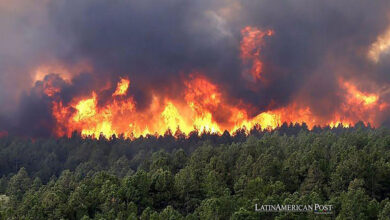Beyond UFOs and Spies, the Important Work of Weather Balloons
Today, the earth's atmosphere is not only teeming with alleged alien ships or Chinese spy balloons. We can also find weather balloons that are responsible for collecting crucial information to understand climate phenomena.

Photo: NASA
LatinAmerican Post | Julián Andrés Pastrana Cuéllar
Listen to this article
Leer en español: Más allá de ovnis y espías, la importante labor de los globos meteorológicos
In recent weeks, the alleged sighting of UFOs has attracted the attention of the media and the public, as well as the shooting down, by the United States government, of a Chinese balloon that, allegedly, would be doing espionage work in the territory of the first economic power in the world. This fact has not stopped generating tensions between this nation and the Asian giant. Well, many of these objects suspended in the Earth's atmosphere do not always correspond to unidentified flying objects of extraterrestrial origin, nor to instruments that act as spies.
In the sky, there have also been, for several years, the so-called weather balloons. According to a UN report, they have become great allies of the Global Observation System, a unit attached to the World Meteorological Organization whose purpose is to collect (through a network of systems financed by the member countries of this multilateral entity), information on surface and in space that allows monitoring the state of the climate throughout the planet Earth.
How do weather balloons work?
According to the UN report, these balloons are made of natural rubber latex or neoprene-based synthetic latex —the latter with a much slower disintegration rate— and inflated with helium and hydrogen. Newly released into the air they measure about two meters, but as they rise in the atmosphere the pressure of the air around them decreases causing the hydrogen or helium to expand, which triples the size of these climate monitoring instruments.
These balloons are equipped with radiosondes that fulfill the role of atmospheric stations carrying out observations in almost a thousand places around the world, two thirds of them concentrating on carrying out these monitoring at noon on the Greenwich Meridian and at midnight. To fully carry out their work, the radiosondes were designed to withstand adverse and extreme weather conditions such as low atmospheric pressure, ice, storms, strong winds, rain, as well as temperatures down to -95 degrees Celsius and relative humidity from 0% to 100%.
Each radiosonde transmits the collected data to the monitoring equipment on land or to ships when dealing with overseas areas. The journey of each balloon lasts an average of two hours, during which time this instrument collects measurements, either at ground level or at an altitude of more than 35 kilometers, on humidity, temperature, and wind speed. Finally, the balloon explodes and he falls to earth with a parachute.
We recommend you read: Solar Energy in Space, ¿Dream or Possible Reality?
The utility of weather balloons
According to what was exposed by the UN, these innovative devices, together with 50 satellites that provide data on space; 4,000 aircraft, 7,300 ships moored and 10,000 observation stations monitoring on the ground; At the same time, 1,650 buoys and 7,300 ships that monitor weather conditions in the ocean deliver vital and reliable information in real time that allows meteorologists to predict the occurrence of phenomena such as storms, for example. They are also key to providing figures that become inputs that help experts to better understand the phenomena related to an increasingly changing climate due to global warming.




